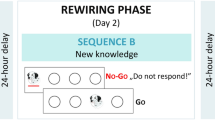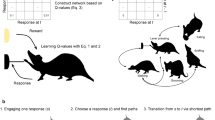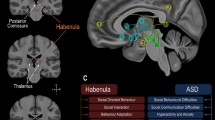Abstract
Behaviours we repeat often tend to become habitual. The process of habit formation in humans is commonly studied in the context of learning an arbitrary association between stimuli and responses. Assessing whether or not this association becomes habitual usually involves testing either whether participants can withhold certain responses or whether participants can generate different responses to certain stimuli. However, studies using these two methods have yielded conflicting findings. Here we propose that this discrepancy arises because these approaches target distinct forms of habit associated with different components of action control: response initiation and response preparation, respectively. Through a series of experiments (total n = 215), along with computational models, we show that these two approaches indeed measure dissociable forms of habit. Our results illustrate that a given behaviour can become habitual in multiple, qualitatively different ways, with important implications for how habits can best be promoted or eliminated.
This is a preview of subscription content, access via your institution
Access options
Access Nature and 54 other Nature Portfolio journals
Get Nature+, our best-value online-access subscription
27,99 € / 30 days
cancel any time
Subscribe to this journal
Receive 12 digital issues and online access to articles
118,99 € per year
only 9,92 € per issue
Buy this article
- Purchase on SpringerLink
- Instant access to full article PDF
Prices may be subject to local taxes which are calculated during checkout






Similar content being viewed by others
Data availability
The data supporting the results of this study are available via GitHub at https://github.com/YueDu-Science/Preparation-versus-Initiation.
Code availability
The code for reproducing the experiment and the results is available via GitHub at https://github.com/YueDu-Science/Preparation-versus-Initiation.
References
Robbins, T. W. & Costa, R. M. Habits. Curr. Biol. 27, R1200–R1206 (2017).
Wood, W. & Neal, D. T. A new look at habits and the habit–goal interface. Psychol. Rev. 114, 843–863 (2007).
Du, Y., Krakauer, J. W. & Haith, A. M. The relationship between habits and motor skills in humans. Trends Cogn. Sci. 26, 371–387 (2022).
Gardner, B. & Lally, P. Habit and habitual behaviour. Health Psychol. Rev. https://doi.org/10.1080/17437199.2022.2105249 (2022).
Graybiel, A. M. & Grafton, S. T. The striatum: where skills and habits meet. Cold Spring Harb. Perspect. Biol. 7, a021691 (2015).
James, W. The Principles of Psychology (Macmillan London, 1890).
Toner, J., Montero, B. G. & Moran, A. The perils of automaticity. Rev. Gen. Psychol. 19, 431–442 (2015).
Wood, W., Quinn, J. M. & Kashy, D. A. Habits in everyday life: thought, emotion, and action. J. Pers. Soc. Psychol. 83, 1281–1297 (2002).
Wood, W. & Rünger, D. Psychology of habit. Annu. Rev. Psychol. 67, 289–314 (2016).
Ach, N. On Volition (trans. Herz, T.) (University of Konstanz, Cognitive Psychology, 2006).
Grol, M. J., de Lange, F. P., Verstraten, F. A., Passingham, R. E. & Toni, I. Cerebral changes during performance of overlearned arbitrary visuomotor associations. J. Neurosci. 26, 117–125 (2006).
Hardwick, R. M., Forrence, A. D., Krakauer, J. W. & Haith, A. M. Time-dependent competition between goal-directed and habitual response preparation. Nat. Hum. Behav. https://doi.org/10.1038/s41562-019-0725-0 (2019).
Hélie, S., Waldschmidt, J. G. & Ashby, F. G. Automaticity in rule-based and information-integration categorization. Atten. Percept. Psychophys. 72, 1013–1031 (2010).
de Wit, S. et al. Shifting the balance between goals and habits: five failures in experimental habit induction. J. Exp. Psychol. Gen. 147, 1043–1065 (2018).
Delorme, C. et al. Enhanced habit formation in Gilles de la Tourette syndrome. Brain 139, 605–615 (2016).
Ersche, K. D. et al. Carrots and sticks fail to change behavior in cocaine addiction. Science 352, 1468–1471 (2016).
Pool, E. R. et al. Determining the effects of training duration on the behavioral expression of habitual control in humans: a multilaboratory investigation. Learn. Mem. 29, 16–28 (2022).
Watson, P., Gladwin, T. E., Verhoeven, A. A. C. & De Wit, S. Investigating habits in humans with a symmetrical outcome-revaluation task. Behav. Res. Methods https://doi.org/10.3758/s13428-022-01922-4 (2022).
Waldschmidt, J. G. & Ashby, F. G. Cortical and striatal contributions to automaticity in information-integration categorization. NeuroImage 56, 1791–1802 (2011).
Ashby, F. G. & Crossley, M. J. Automaticity and multiple memory systems. WIREs Cogn. Sci. 3, 363–376 (2012).
Luque, D., Molinero, S., Watson, P., López, F. J. & Le Pelley, M. E. Measuring habit formation through goal-directed response switching. J. Exp. Psychol. Gen. 149, 1449–1459 (2020).
MacLeod, C. M. & Dunbar, K. Training and Stroop-like interference: evidence for a continuum of automaticity. J. Exp. Psychol. Learn. Mem. Cogn. 14, 126–135 (1988).
Tricomi, E., Balleine, B. W. & O’Doherty, J. P. A specific role for posterior dorsolateral striatum in human habit learning. Eur. J. Neurosci. 29, 2225–2232 (2009).
De Houwer, J., Tanaka, A., Moors, A. & Tibboel, H. Kicking the habit: why evidence for habits in humans might be overestimated. Motiv. Sci. 4, 50–59 (2018).
Ceceli, A. O., Myers, C. E. & Tricomi, E. Demonstrating and disrupting well-learned habits. PLoS ONE 15, e0234424 (2020).
Watson, P. & de Wit, S. Current limits of experimental research into habits and future directions. Curr. Opin. Behav. Sci. 20, 33–39 (2018).
Carlsen, A. N., Chua, R., Inglis, J. T., Sanderson, D. J. & Franks, I. M. Prepared movements are elicited early by startle. J. Mot. Behav. 36, 253–264 (2004).
Haith, A. M. & Bestmann, S. in The Cognitive Neurosciences (eds Poeppel, D. et al.) 541–548 (MIT Press, 2020).
Haith, A. M., Pakpoor, J. & Krakauer, J. W. Independence of movement preparation and movement initiation. J. Neurosci. 36, 3007–3015 (2016).
Heckman, R. L., Ludvig, D. & Perreault, E. J. A motor plan is accessible for voluntary initiation and involuntary triggering at similar short latencies. Exp. Brain Res. 241, 2395–2407 (2023).
Churchland, M. M. & Shenoy, K. V. Preparatory activity and the expansive null-space. Nat. Rev. Neurosci. 25, 213–236 (2024).
Kaufman, M. T. et al. The largest response component in the motor cortex reflects movement timing but not movement type. eNeuro 3, 477–490 (2016).
Kobler, R. J., Kolesnichenko, E., Sburlea, A. I. & Müller-Putz, G. R. Distinct cortical networks for hand movement initiation and directional processing: an EEG study. NeuroImage 220, 117076 (2020).
Lara, A. H., Elsayed, G. F., Zimnik, A. J., Cunningham, J. P. & Churchland, M. M. Conservation of preparatory neural events in monkey motor cortex regardless of how movement is initiated. eLife 7, e31826 (2018).
Wickelgren, W. A. Speed–accuracy tradeoff and information processing dynamics. Acta Psychol. 41, 67–85 (1977).
Du, Y., Forrence, A. D., Metcalf, D. M. & Haith, A. M. Action initiation and action inhibition follow the same time course when compared under matched experimental conditions. J. Neurophysiol. 131, 757–767 (2024).
Bächtold, D., Baumüller, M. & Brugger, P. Stimulus–response compatibility in representational space. Neuropsychologia 36, 731–735 (1998).
Dehaene, S., Bossini, S. & Giraux, P. The mental representation of parity and number magnitude. J. Exp. Psychol. Gen. 122, 371–396 (1993).
Fias, W. & Fischer, M. H. in The Handbook of Mathematical Cognition (ed. Campbell, J.) 43–54 (Psychology Press, 2005).
Fischer, M. H., Castel, A. D., Dodd, M. D. & Pratt, J. Perceiving numbers causes spatial shifts of attention. Nat. Neurosci. 6, 555–556 (2003).
Gevers, W., Reynvoet, B. & Fias, W. The mental representation of ordinal sequences is spatially organized. Cognition 87, B87–B95 (2003).
Mathieu, R., Gourjon, A., Couderc, A., Thevenot, C. & Prado, J. Running the number line: rapid shifts of attention in single-digit arithmetic. Cognition 146, 229–239 (2016).
Zhang, M. et al. Spatial representation of ordinal information. Front. Psychol. 7, 505 (2016).
Heitz, R. P. The speed–accuracy tradeoff: history, physiology, methodology, and behavior. Front. Neurosci. 8, 150 (2014).
Liesefeld, H. R. & Janczyk, M. Combining speed and accuracy to control for speed-accuracy trade-offs(?). Behav. Res. 51, 40–60 (2019).
Hick, W. E. On the rate of gain of information. Q. J. Exp. Psychol. 4, 11–26 (1952).
Proctor, R. W. & Schneider, D. W. Hick’s law for choice reaction time: a review. Q. J. Exp. Psychol. 71, 1281–1299 (2018).
Du, Y. & Haith, A. Habits are not automatic. Preprint at PsyArXiv https://doi.org/10.31234/osf.io/gncsf (2023).
Du, Y. & Haith, A. Seemingly ‘habitual’ responses can be caused by both habits and strategic action selection. OSF https://osf.io/7qs4r/download (2024).
Van Dessel, P. et al. Exploring the role of goal-dependent processes in action slips under time pressure. Motiv. Sci. 10, 128–137 (2024).
Daw, N. D., Niv, Y. & Dayan, P. Uncertainty-based competition between prefrontal and dorsolateral striatal systems for behavioral control. Nat. Neurosci. 8, 1704–1711 (2005).
Thorndike, E. L. Animal intelligence: an experimental study of the associative processes in animals. Psychol. Rev. Monogr. Suppl. 2, i–109 (1898).
Miller, K. J., Shenhav, A. & Ludvig, E. A. Habits without values. Psychol. Rev. 126, 292–311 (2019).
Piray, P. & Daw, N. D. Linear reinforcement learning in planning, grid fields, and cognitive control. Nat. Commun. 12, 4942 (2021).
Nebe, S., Kretzschmar, A., Brandt, M. C. & Tobler, P. N. Characterizing human habits in the lab. Collabra Psychol. 10, 92949 (2024).
Adams, C. D. Variations in the sensitivity of instrumental responding to reinforcer devaluation. Q. J. Exp. Psychol. Sect. B 34, 77–98 (1982).
Dickinson, A. Actions and habits: the development of behavioural autonomy. Phil. Trans. R. Soc. Lond. B 308, 67–78 (1985).
Colwill, R. M. An associative analysis of instrumental learning. Curr. Dir. Psychol. Sci. 2, 111–116 (1993).
Watson, P. in Habits (ed. Vandaele, Y.) 3–22 (Springer International, 2024); https://doi.org/10.1007/978-3-031-55889-4_1
de Wit, S., Barker, R. A., Dickinson, A. D. & Cools, R. Habitual versus goal-directed action control in Parkinson disease. J. Cogn. Neurosci. 23, 1218–1229 (2011).
Everitt, B. J. & Robbins, T. W. Drug addiction: updating actions to habits to compulsions ten years on. Annu. Rev. Psychol. 67, 23–50 (2016).
Hommel, B. & Wiers, R. W. Towards a unitary approach to human action control. Trends Cogn. Sci. 21, 940–949 (2017).
Colwill, R. M. & Rescorla, R. A. in Psychology of Learning and Motivation (ed. Bower, G. H.) Vol. 20, 55–104 (Elsevier, 1986).
Holland, P. C. Cognitive versus stimulus–response theories of learning. Learn. Behav. 36, 227–241 (2008).
Berner, L. A. et al. Impaired belief updating and devaluation in adult women with bulimia nervosa. Transl. Psychiatry 13, 2 (2023).
Buabang, E. K. et al. A goal-directed account of action slips: the reliance on old contingencies. J. Exp. Psychol. Gen. 152, 496–508 (2023).
De Houwer, J., Buabang, E. K., Boddez, Y., Köster, M. & Moors, A. Reasons to remain critical about the literature on habits: a commentary on Wood et al. (2022). Perspect. Psychol. Sci. 18, 871–875 (2023).
de Wit, S. et al. Corticostriatal connectivity underlies individual differences in the balance between habitual and goal-directed action control. J. Neurosci. 32, 12066–12075 (2012).
Sjoerds, Z. et al. Slips of action and sequential decisions: a cross-validation study of tasks assessing habitual and goal-directed action control. Front. Behav. Neurosci. 10, 234 (2016).
Haggard, P. Human volition: towards a neuroscience of will. Nat. Rev. Neurosci. 9, 934–946 (2008).
Elsayed, G. F., Lara, A. H., Kaufman, M. T., Churchland, M. M. & Cunningham, J. P. Reorganization between preparatory and movement population responses in motor cortex. Nat. Commun. 7, 13239 (2016).
De Rugy, A., Loeb, G. E. & Carroll, T. J. Muscle coordination is habitual rather than optimal. J. Neurosci. 32, 7384–7391 (2012).
Jurado-Parras, M.-T. et al. The dorsal striatum energizes motor routines. Curr. Biol. 30, 4362–4372.e6 (2020).
Mannell, R. C. & Duthie, J. H. Habit lag: when ‘automatization’ is dysfunctional. J. Psychol. 89, 73–80 (1975).
Verstynen, T. & Sabes, P. N. How each movement changes the next: an experimental and theoretical study of fast adaptive priors in reaching. J. Neurosci. 31, 10050–10059 (2011).
Wong, A. L., Goldsmith, J., Forrence, A. D., Haith, A. M. & Krakauer, J. W. Reaction times can reflect habits rather than computations. eLife 6, e28075 (2017).
Haith, A. M., Huberdeau, D. M. & Krakauer, J. W. The influence of movement preparation time on the expression of visuomotor learning and savings. J. Neurosci. 35, 5109–5117 (2015).
Mirabella, G., Pani, P. & Ferraina, S. Neural correlates of cognitive control of reaching movements in the dorsal premotor cortex of rhesus monkeys. J. Neurophysiol. 106, 1454–1466 (2011).
Resulaj, A., Kiani, R., Wolpert, D. M. & Shadlen, M. N. Changes of mind in decision-making. Nature 461, 263–266 (2009).
Gardner, B. et al. Developing habit-based health behaviour change interventions: twenty-one questions to guide future research. Psychol. Health 38, 518–540 (2023).
Kok, G. et al. A taxonomy of behaviour change methods: an intervention mapping approach. Health Psychol. Rev. 10, 297–312 (2016).
Lally, P. & Gardner, B. Promoting habit formation. Health Psychol. Rev. 7, S137–S158 (2013).
Michie, S. & Prestwich, A. Are interventions theory-based? Development of a theory coding scheme. Health Psychol. 29, 1–8 (2010).
Quinn, J. M., Pascoe, A., Wood, W. & Neal, D. T. Can’t control yourself? Monitor those bad habits. Pers. Soc. Psychol. Bull. 36, 499–511 (2010).
Ashby, F. G., Turner, B. O. & Horvitz, J. C. Cortical and basal ganglia contributions to habit learning and automaticity. Trends Cogn. Sci. 14, 208–215 (2010).
Balsters, J. H. & Ramnani, N. Cerebellar plasticity and the automation of first-order rules. J. Neurosci. 31, 2305–2312 (2011).
Desmurget, M. & Turner, R. S. Motor sequences and the basal ganglia: kinematics, not habits. J. Neurosci. 30, 7685–7690 (2010).
Hélie, S. & Cousineau, D. The cognitive neuroscience of automaticity: behavioral and brain signatures. Cogn. Sci. 6, 35–53 (2011).
Wu, T., Kansaku, K. & Hallett, M. How self-initiated memorized movements become automatic: a functional MRI study. J. Neurophysiol. 91, 1690–1698 (2004).
Yin, H. H. & Knowlton, B. J. The role of the basal ganglia in habit formation. Nat. Rev. Neurosci. 7, 464–476 (2006).
Dolan, R. J. & Dayan, P. Goals and habits in the brain. Neuron 80, 312–325 (2013).
Haith, A. M. & Krakauer, J. W. The multiple effects of practice: skill, habit and reduced cognitive load. Curr. Opin. Behav. Sci. 20, 196–201 (2018).
Cisek, P. & Kalaska, J. F. Neural correlates of reaching decisions in dorsal premotor cortex: specification of multiple direction choices and final selection of action. Neuron 45, 801–814 (2005).
Cisek, P. & Kalaska, J. F. Neural mechanisms for interacting with a world full of action choices. Annu. Rev. Neurosci. 33, 269–298 (2010).
Crammond, D. J. & Kalaska, J. F. Modulation of preparatory neuronal activity in dorsal premotor cortex due to stimulus–response compatibility. J. Neurophysiol. 71, 1281–1284 (1994).
Wise, S. P. & Murray, E. A. Arbitrary associations between antecedents and actions. Trends Neurosci. 23, 271–276 (2000).
Dudman, J. T. & Krakauer, J. W. The basal ganglia: from motor commands to the control of vigor. Curr. Opin. Neurobiol. 37, 158–166 (2016).
Park, J., Coddington, L. T. & Dudman, J. T. Basal ganglia circuits for action specification. Annu. Rev. Neurosci. 43, 485–507 (2020).
Thura, D. & Cisek, P. The basal ganglia do not select reach targets but control the urgency of commitment. Neuron 95, 1160–1170 (2017).
Turner, R. S. & Desmurget, M. Basal ganglia contributions to motor control: a vigorous tutor. Curr. Opin. Neurobiol. 20, 704–716 (2010).
Vandaele, Y. & Ahmed, S. H. Habit, choice, and addiction. Neuropsychopharmacology 46, 689–698 (2021).
Gillan, C. M. et al. Disruption in the balance between goal-directed behavior and habit learning in obsessive-compulsive disorder. Am. J. Psychiatry 168, 718–726 (2011).
Fujisawa, S., Amarasingham, A., Harrison, M. T. & Buzsáki, G. Behavior-dependent short-term assembly dynamics in the medial prefrontal cortex. Nat. Neurosci. 11, 823–833 (2008).
Acknowledgements
This work was supported by National Science Foundation Grant No. 2218406 to A.M.H.
Author information
Authors and Affiliations
Contributions
Y.D. and A.M.H. conceptualized the experiments and wrote the manuscript. Y.D. programmed the task, collected and analysed the data, and prepared the figures.
Corresponding author
Ethics declarations
Competing interests
The authors declare no competing interests.
Peer review
Peer review information
Nature Human Behaviour thanks David Luque, Klaus Rothermund and Poppy Watson for their contribution to the peer review of this work. Peer reviewer reports are available.
Additional information
Publisher’s note Springer Nature remains neutral with regard to jurisdictional claims in published maps and institutional affiliations.
Supplementary information
Rights and permissions
Springer Nature or its licensor (e.g. a society or other partner) holds exclusive rights to this article under a publishing agreement with the author(s) or other rightsholder(s); author self-archiving of the accepted manuscript version of this article is solely governed by the terms of such publishing agreement and applicable law.
About this article
Cite this article
Du, Y., Haith, A.M. Dissociable habits of response preparation versus response initiation. Nat Hum Behav (2025). https://doi.org/10.1038/s41562-025-02215-4
Received:
Accepted:
Published:
DOI: https://doi.org/10.1038/s41562-025-02215-4



